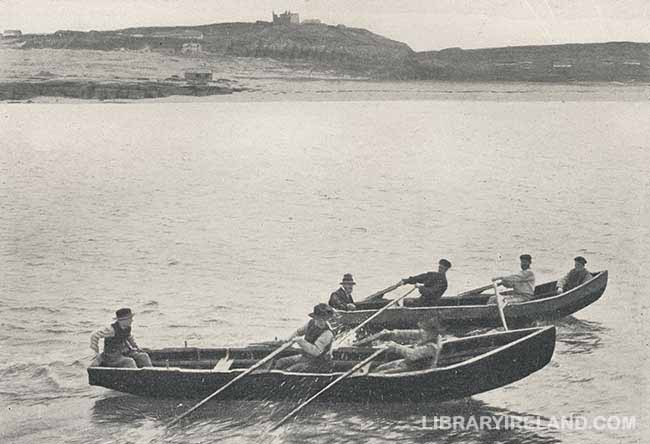Aranmore
Mr. Walker then took us to a lace-making school which his Board had established on the island, and we saw the young girls making fine laces in a neat building that had at one time been a church. The instructress had been on the island for more than a year, and Mr. Walker at once gave her a much-needed vacation.
Standing on the shore, I asked a man, "Are there many lobsters here?" "Sure, the shores is red wid 'em, yer honor, in the height of the saison!" was his ready reply.

Curraghs, Aran Islands
We again got into a curragh, boarded the steamer, and were under way in a trice for Aranmore, the largest island of the group, where we landed an hour later at a fine pier built by the Congested Districts Board. The village is called Kilronan, and the inhabitants live by fishing. They are a simple and peculiar people, descended from the Firbolgs, retaining some parts of the dress and many of the customs of that race. Their footwear consists of a coarse stocking, over which they wear a tight-fitting slipper of raw cowhide with the hair on it, called a "pampootie." This is a special shoe for use on the smooth and slippery rocks of these islands. They also wear a snug, homespun flannel jacket and short "pants," the whole making an exceedingly picturesque and effective outfit for their work. They have no pockets for handkerchiefs, cigars, eye-glasses, gloves, or even small change, but they seem to get on very well without them.
Read "On an Irish Jaunting Car through Donegal and Connemara" at your leisure
Read On an Irish jaunting Car through Donegal and Connemara at your leisure and help support this free Irish library.
Samuel Gamble Bayne was born in Ramelton, County Donegal, and educated at Queen's University in Belfast. At the age of twenty-five he left for America with a view to making his fortune. He invested in an oil well in Pennsylvania and later founded a bank which subsequently came to be the JP Morgan Chase bank in New York. By the time this book was written he was wealthy enough to be referred to as a billionaire. His account of the tour through the north, west and south of Ireland is a pleasant snapshot of how that part of the country was in the early part of the 20th century. He describes what is to be seen, gives some background history and, through the illustrations especially, provides wonderful glimpses of the area's social history.
The ebook is available in .mobi, .epub, and .pdf formats. See details ».

